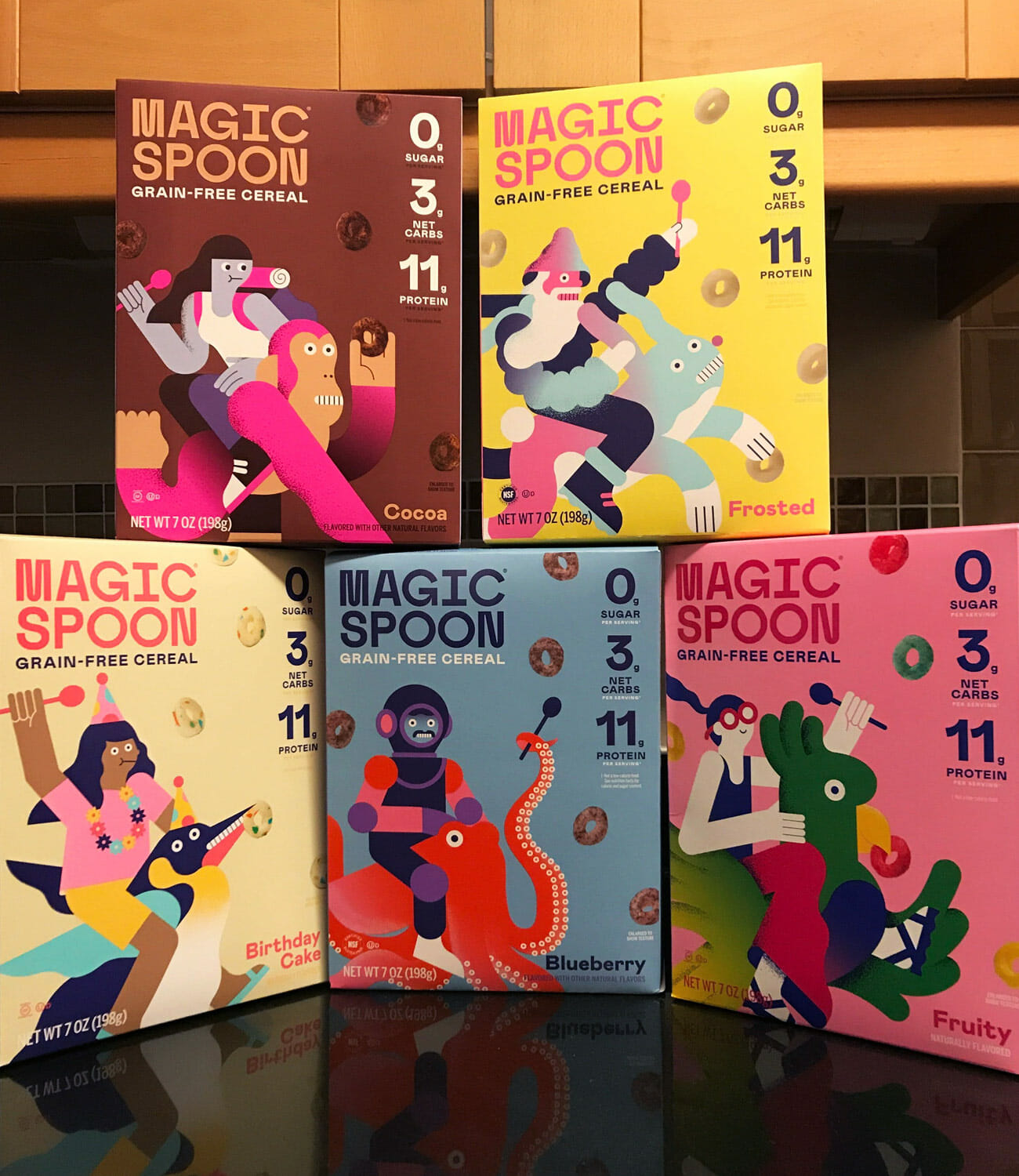Gabi Lewis and Greg Sewitz grew up scarfing down bowls of sugary cereal watching Saturday morning cartoons (Recess and Rugrats, respectively). In an effort to capture that nostalgia, minus the risks associated with high-sugar diets, the two created Magic Spoon, an internet cereal brand that, according to its founders, has seen a major uptick in sales since the spread of coronavirus.
According to the box, Magic Spoon is the “high-protein, keto-friendly, non-GMO, gluten-free, grain-free, soy-free, wheat-free, nothing artificial, childlike cereal for grown-ups.” That’s a lot of things missing, which makes you wonder: what’s left?
What’s Good
Magic Spoon’s catalog of cereals — which include Fruity, Frosted, Cocoa, Cinnamon, Blueberry and Birthday Cake — rely on a sweetener blend of allulose, monk fruit and stevia. While monk fruit and stevia have been used to sweeten healthier versions of unhealthy foods for years (both are very popular in the low- and no-alcohol booze sector), allulose is a newcomer in the sugar alternative game.
Derived from foods like figs and kiwi, it has a tenth of the calories of cane sugar and 70 percent of the sweetness. The FDA doesn’t require zero-calorie sweeteners to be listed on the nutrition facts as added sugar, but it does require them to be counted under total carbohydrates. Unlike “bad” carbs — such as white flour — allulose is not completely metabolized by the body, so it doesn’t affect blood sugar or insulin levels. Magic Spoon has a listed 10 grams of total carbs, but factoring in the 6 grams of allulose and 1 gram of fiber, each serving nets only 3 grams of carbs.
The founders relied on their sweetener blend to mimic the sweetness of real sugar and to eliminate the aftertaste associated with sugar alternatives, which I must commend them on, because it works.

The texture of Magic Spoon’s cereal was one highlight I noticed immediately. Its crunch is comparable to a cereal like Froot Loops or Apple Jacks. There’s also an airiness to Magic Spoon’s cereal that’s reminiscent of Gerber’s Puffs, a cereal snack for babies (don’t ask me why I’ve eaten these). The texture of Magic Spoon’s cereal has a satisfying bite to it, and the airiness doesn’t make them feel too dense. Given it’s totally grain-free, this is impressive.
Each box of cereal has 11 grams of protein whereas competitors will have between 1 to 7 grams of protein. While competitors list sugar as their first ingredient, Magic Spoon’s first ingredient is a milk protein blend. For me, this translated to cereal that kept me full enough until lunchtime, a feat most cereals fail at. Last thing: the package design rules.
What’s Not as Good
If you’re looking for Milk Bar-level cereal milkiness, you’re not going to get it with Magic Spoon. For me, that’s a good thing; but I imagine some cereal lovers might be looking for the sickly sweet milk that comes after eating a bowl of Cinnamon Toast Crunch. The milk at the end of the bowl of Magic Spoon isn’t so sweet that it feels like it’ll dig a cavity in my teeth, but is flavorful enough that it doesn’t feel like I’m drinking straight milk.
My biggest issue with Magic Spoon’s cereal is that, once chewed, the remnants start to gum up in my mouth. This is particularly noticeable when eating the cereal dry, which began to feel like Laffy Taffy stuck in my teeth. The issue is less prevalent when the cereal is eaten with milk, but a nuisance nonetheless.

Lorem ipsum dolor sit amet, consectetur adipiscing elit.
Alternatives
The direct-to-consumer healthy cereal space is still fairly new. Some competitors include Catalina Crunch, HighKey and The Cereal School. It seems each brand corners the market on a cereal shape — rings, spheres, kernels — but they all have similar selling points. For example, they all use natural sweeteners, market themselves as a healthy option and even a few hit on the nostalgia factor. Each brand’s price per bowl also tends to hover around $1 to $2.
Verdict
It’s easy to start snacking on the cereal and find yourself elbow deep in a box before you realize how much you’ve eaten. Each cereal captures the essence of the cereals they are based on. Blueberry, Magic Spoon’s take on on General Mills’ Boo Berry, and Cocoa, based on General Mills’ Cocoa Puffs, were my favorites. Magic Spoon costs $39 for a four-pack, and a bowl works out to $1.39. I found each 3/4-cup serving to be filling enough to hold me over until lunch without having to reach for snack in between.
Of course, like beauty, a cereal’s goodness is a matter of subjective taste. I tend to opt for savory breakfasts over sweet ones, but Magic Spoon had me reaching for a bowl of cereal over a plate of bacon. If you can stomach the cost of paying around $10 a box, then Magic Spoon justifies the price for the quality of its ingredients alone. Combined with the flavor and nostalgia factor, Magic Spoon made a product worth stocking up on.
Magic Spoon provided this product for review.




